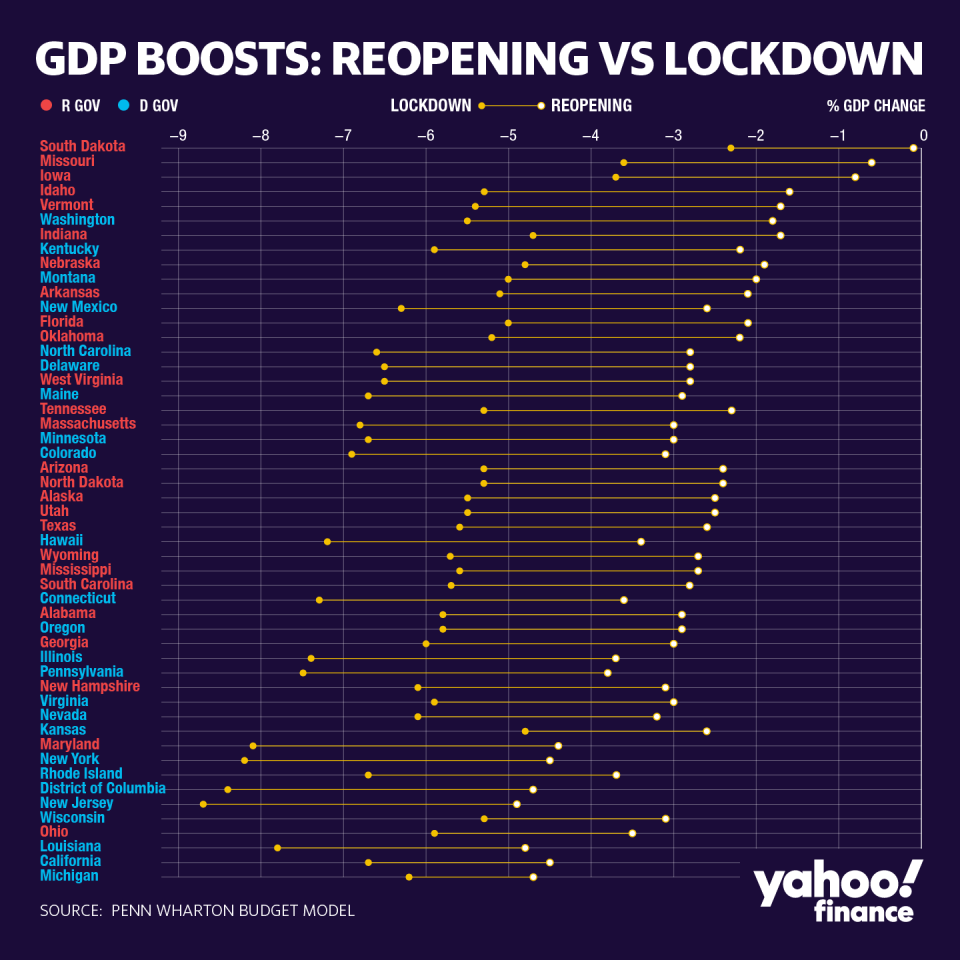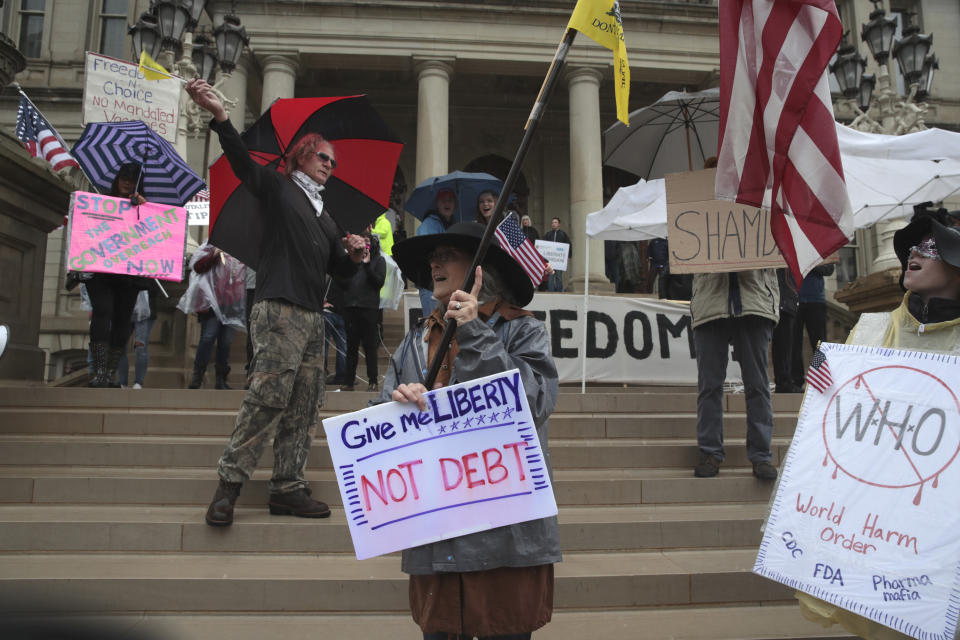Republican states to see biggest economic boosts from reopening amid coronavirus crisis
According to economic projections from the Penn Wharton Budget Model, states with Republican governors are forecast to see bigger economic gains by July 24 from reopening compared to states with Democratic ones.
Yahoo Finance analyzed the Wharton Model’s projections of GDP declines for all 50 states and the District of Columbia under each of three scenarios: lockdown, partial reopening, and fully reopening with and without social distancing. The analysis also calculated the percentage boost each state is forecasted to experience if they reopened their state with social distancing in place compared to remaining under lockdown.
Currently, most states have decided to fully or partially reopen, with New Jersey, Illinois, Michigan, and Delaware as the remaining holdouts in lockdown. They all plan to open by June 1.
But even if all states were to reopen, Republican states will find the GDP losses they face as a result of the coronavirus pandemic are less than the ones facing their Democratic counterparts.
The Yahoo Finance analysis found that of the top 10 states projected to have the biggest economic boosts from reopening, 7 have Republican leadership.
South Dakota, the top state on the list will see a GDP decline of 2.3%, according to the Wharton model forecasts. But reopening with social distancing rules in place will see economic losses in the state shrink to a 0.1% decline year over year – a difference of nearly 96%.
The state’s governor, Kristi Noem, reopened South Dakota at the end of April and put a “Back to Normal” plan in place that encouraged good hygiene and following CDC guidelines. South Dakota has had over 4,000 positive cases with roughly 50 deaths.
But if the state had reopened with no social distancing rules in place at all, its GDP was projected to increase by 2% over last year. This means that compared to staying in lockdown, South Dakota would see a 187% increase from its GDP decline.
That scenario however, remains unlikely for all states.

Other states that are forecast to see the largest boosts in their GDP projections as they reopen compared to the GDP declines from staying in lockdown include Missouri (83%), Iowa (78%), Idaho (70%), and Vermont (69%).
The only states with Democratic governors that cracked the top 10 include Washington, Kentucky, and Montana.
Washington state, one of the worst hit by the COVID-19 crisis, was forecast to see a 5.5% GDP decline compared to last year if it chose to stay under lockdown. But by reopening with social distancing guidelines in place, GDP is expected to decline by 1.8% year over year, according to the Wharton model.
Governor and former presidential hopeful Jay Inslee unveiled the state’s “Safe Start” plan at the beginning of May. According to the governor’s office, the state is currently in Phase 1 of the plan, with some counties authorized to move into Phase 2.
Of the 26 states projected to see the largest economic boosts, over 65% have Republican leadership.
On the opposite end of the list, states with Democratic governors will see the smallest economic gains from reopening their states.
At the bottom of the list is Michigan, which will only see a 24% change in its GDP after it reopens compared to the GDP decline under lockdown. The state currently has a stay-at-home order in place until May 28, but Gov. Gretchen Whitmer plans to allow bars, restaurants, and retail stores to reopen in some parts of the state this week.

Ohio and Maryland, the only Republican states at the bottom of the list, are forecast to experience GDP bumps of 41% and 46%, respectively, by reopening compared to remaining under lockdown.
Other states forecast to see the smallest GDP increases from reopening compared to lockdown include New York, New Jersey, the District of Columbia, and California.
Democratic states are forecast to suffer the most economically from lockdowns with New Jersey’s GDP declines projected at 8.7% compared to last year. The state has a reopening plan in place, with no date set as yet.
Faculty director of the PWBM Dr. Kent Smetters said that while there is no causal link between the political affiliation of the states’ governors and their GDP projections, there is correlation.
Blue states, he said, are typically denser, and therefore were far more “aggressive” in their social distancing and lockdown policies than their Republican counterparts.
Some states like New York and California suffered from large GDP losses from coronavirus due to density, industry composition, and ages of residents.
“They were hit pretty hard in policy or by social distancing, so their GDP went down quite a bit,” he explained.
“These states tended to clamp down harder,” Smetters said. “It’s ultimately a trade-off. They would have had more cases if they hadn’t, but they also gave up more GDP as a result.”
After being so badly hit, these states won’t likely see the same boost from reopening compared to their counterparts. Even in reopening, states like Michigan and New York have created aggressive social distancing policies going forward, with only certain regions allowed to open back again.
The data represents the economic trade-off many government officials must make as the death toll in the United States has risen to nearly 94,000, according to the Johns Hopkins COVID-19 tracker. There are over 1.5 million positive cases countrywide, with death toll projections from the Penn Wharton Budget Model as high as 231,000.
Kristin Myers is a reporter at Yahoo Finance. Follow her on Twitter.
Read more:
Over 4 million in US will contract coronavirus if states fully reopen: Wharton model
Greatest increases of COVID deaths projected in Republican states
Projected US coronavirus death toll rises to 138,000 as more states mull reopening
Reopening states: No ‘clear’ federal guidance: Kansas City Mayor
Reopening states will cause 233,000 more people to die from coronavirus, according to Wharton model
Read the latest financial and business news from Yahoo Finance
Follow Yahoo Finance on Twitter, Facebook, Instagram, Flipboard, LinkedIn, YouTube, and reddit.
